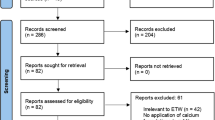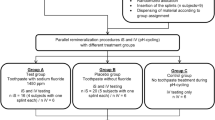Key Points
-
This manuscript discusses an investigation of the relationship between chemical parameters of popular soft drinks and enamel erosion.
-
The effects of toothbrushing after exposure to soft drinks are described as a function of the chemical parameters of the drink.
-
Clinically relevant times for erosion and brushing are used in this in vitro study.
-
A correlation is drawn between the amount of tissue loss caused by erosion, and the extent of the softened layer, in that drinks which cause greater erosion also cause a thicker softened layer.
Abstract
Objective To investigate how enamel loss due to erosion, and due to cycling of erosion and abrasion, depends on compositional parameters of soft drinks, and particularly whether the thickness of the erosive softened layer is a function of drink composition.
Setting University dental hospital research laboratory in the UK, 2004.
Materials and methods Six drinks were chosen based on their popularity and composition: apple juice, orange juice, apple drink, orange drink, cranberry drink and 'ToothKind' blackcurrant drink. Group A samples (n = 36) were exposed to soft drinks at 36°C for six consecutive 10 minute periods. Group B samples (n = 36) were subjected to alternating erosion and toothbrushing, repeated six times. Enamel loss was measured using optical profilometry.
Results Group A: significant enamel loss was seen for all drinks (p < 0.001). Erosion was correlated with pH and calcium concentration but not phosphate concentration or titratable acidity. Group B: significant additional material loss due to toothbrush abrasion occurred with all drinks. Abrasive enamel loss differed between the drinks and was positively correlated with drink erosive potential.
Conclusion Enamel loss by erosion is exacerbated by subsequent abrasion. The amount of softened enamel removed by toothbrushing is a function of the chemical composition of the erosive medium.
Similar content being viewed by others
Log in or create a free account to read this content
Gain free access to this article, as well as selected content from this journal and more on nature.com
or
References
Imfeld T . Dental erosion. Definition, classification and links. Eur J Oral Sci 1996; 104: 151–155.
Nunn J H, Gordon P H, Morris A J, Pine C M, Walker A . Dental erosion - changing prevalence? A review of British national children's surveys. Int J Paediatr Dent 2003; 13: 98–105.
Meurman J H, ten Cate J M . Pathogenesis and modifying factors of dental erosion. Eur J Oral Sci 1996; 104: 199–206.
Zero D, Lussi A . Etiology of enamel erosion: intrinsic and extrinsic factors. In Addy M, Embery G, Edgar W M, Orchardson R (eds) Tooth Wear and Sensitivity. Clinical Advances in Restorative Dentistry. pp 122–139. London: Taylor and Francis, 2000.
Dugmore C R, Rock W P . A multifactorial analysis of factors associated with dental erosion. Br Dent J 2004; 196: 283–286.
Al-Dlaigan Y H, Shaw L, Smith A J . Dental erosion in a group of British 14-year-old school children. Part II: Influence of dietary intake. Br Dent J 2001; 190: 258–261.
Lussi A, Jaggi T, Scharer S . The influence of different factors on in vitro enamel erosion. Caries Res 1993; 27: 387–393.
Larsen M J, Nyvad B . Enamel erosion by some soft drinks and orange juices relative to their pH, buffering effect and contents of calcium phosphate. Caries Res 1999; 33: 81–87.
Shaw L, Smith A J . Dental erosion - the problem and some practical solutions. Br Dent J 1998; 186: 115–118.
Zero D T . Etiology of dental erosion - extrinsic factors. Eur J Oral Sci 1996; 104: 162–177.
Grobler S R, Jenkins G N, Kotze D . The effects of the composition and method of drinking of soft drinks on plaque pH. Br Dent J 1985; 158: 293–296.
Attin T, Buchalla W, Gollner M, Hellwig E . Use of variable remineralization periods to improve the abrasion resistance of previously eroded enamel. Caries Res 2000; 34: 48–52.
Eisenburger M, Addy M . Influence of liquid temperature and flow rate on enamel erosion and surface softening. J Oral Rehab 2003; 30: 1076–1080.
Davis W B, Winter P J . The effect of abrasion on enamel and dentine after exposure to dietary acid. Br Dent J 1980; 148: 253–256.
Van der Weijden F, Danser M M . Toothbrushes: benefits versus effects on hard and soft tissues. In Addy M, Embery G, Edgar W M, Orchardson R (eds) Tooth Wear and Sensitivity. Clinical Advances in Restorative Dentistry. pp 217–236. London: Taylor and Francis, 2000.
Amaechi B T, Higham S M, Edgar W M . Use of transverse microradiography to quantify mineral loss by erosion in bovine enamel. Caries Res 1998; 32: 351–356.
Eisenburger M, Addy M . Evaluation of pH and erosion time on demineralisation. Clin Oral Investigations 2001; 5: 108–111.
Bartlett D W, Smith B G, Wilson R F . Comparison of the effect of fluoride and non-fluoride toothpaste on tooth wear in vitro and the influence of enamel fluoride concentration and hardness of enamel. Br Dent J 1994; 176: 346–348.
Torrado A, Valiente M, Munoz C A . Cleaning power and abrasivity of a new toothpaste based on ion-exchange resins. Am J Dent 2004; 17: 80–84.
Litonjua L A, Andreana S, Bush P J, Tobias T S, Cohen R E . Wedged cervical lesions produced by toothbrushing. Am J Dent 2004; 17: 237–240.
Chen P S, Toribara T Y, Warner H . Microdetermination of phosphorus. Anal Chem 1956; 28: 1756–1758.
Dyer D, Addy M, Newcombe R G . Studies in vitro of abrasion by different manual toothbrush heads and a standard toothpaste. J Clin Periodontol 2000; 27: 99–103.
Feldman M, Barnett C . Relationships between the acidity and osmolality of popular beverages and reported postprandial heartburn. Gastroenterology 1995; 108: 125–131.
Lussi A, Jaeggi T, Zero D T . The role of diet in the aetiology of dental erosion. Caries Res 2004; 38: 34–44.
Shellis R P, Finke M, Eisenburger M, Parker D M, Addy M . Relationship between enamel erosion and liquid flow rate. Eur J Oral Sci 2005; 113: 232–238.
Dorozhkin S V . Surface reactions of apatite dissolution. J Colloid Interface Sci 1997; 191: 489–497.
Barbour M E, Parker D M, Allen G C, Jandt K D . Enamel dissolution in citric acid as a function of calcium and phosphate concentrations and degree of saturation with respect to hydroxyapatite. Eur J Oral Sci 2003; 111: 428–433.
ten Cate J M . Chemistry of demineralization and remineralization of enamel and dentine. In Addy M, Embery G, Edgar W M, Orchardson R (eds) Tooth Wear and Sensitivity. Clinical Advances in Restorative Dentistry. pp 153–160. London: Taylor and Francis, 2000.
Acknowledgements
We gratefully acknowledge GlaxoSmithKline for funding this research.
Author information
Authors and Affiliations
Corresponding author
Additional information
Refereed Paper
Rights and permissions
About this article
Cite this article
Hemingway, C., Parker, D., Addy, M. et al. Erosion of enamel by non-carbonated soft drinks with and without toothbrushing abrasion. Br Dent J 201, 447–450 (2006). https://doi.org/10.1038/sj.bdj.4814073
Accepted:
Published:
Issue date:
DOI: https://doi.org/10.1038/sj.bdj.4814073
This article is cited by
-
Validation of an erosive tooth wear risk factors questionnaire for adolescents
Clinical Oral Investigations (2022)
-
Oral diseases and oral health related behaviors in adolescents living in Maasai population areas of Tanzania: a cross-sectional study
BMC Pediatrics (2019)
-
Erosive characteristics and fluoride content of cola-type drinks
British Dental Journal (2016)
-
Erosive potential of energy drinks on the dentine surface
BMC Research Notes (2013)
-
Thickness of softened human enamel removed by toothbrush abrasion: an in vitro study
Clinical Oral Investigations (2010)



